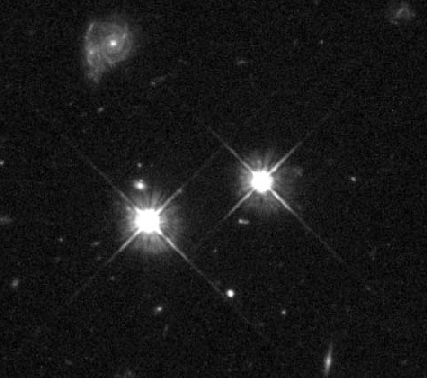Explanation: Here is a rather typical quasar. But since quasars are so unusual it is quite atypical of most familiar objects. Of the two bright objects in the center of this photo, the quasar is on the left. The bright image to quasar's right is a star, the faint object just above the quasar is an elliptical galaxy, with an apparently interacting pair of spiral galaxies near the top. Quasars appear as unresolved points of light, as do stars, and hence quasars were thought to be a type of star until the 1960s. We now know that the brightest quasars lie far across the visible universe from us, and include the most distant objects known. Quasars may occupy the centers of galaxies and may even be much brighter than their host galaxies. In fact, the centers of many nearby galaxies have similarities to quasars - including the center of our own Milky Way Galaxy. The exact mechanism responsible for a quasar's extreme brightness is unknown, but thought to involve supermassive black holes. This picture represents a milestone for the six-year-old Hubble Space Telescope as it was picture number 100,000, taken on June 22, 1996.
1999 2000 2001 2002 2003 2004 2005 2006 2007 2008 2009 2010 2011 2012 2013 2014 2015 2016 2017 2018 2019 2020 2021 2022 2023 2024 2025 |
Yanvar' Fevral' Mart Aprel' Mai Iyun' Iyul' Avgust Sentyabr' Oktyabr' Noyabr' Dekabr' |
NASA Web Site Statements, Warnings, and Disclaimers
NASA Official: Jay Norris. Specific rights apply.
A service of: LHEA at NASA / GSFC
& Michigan Tech. U.
|
Publikacii s klyuchevymi slovami:
kvazary - yadra aktivnyh galaktik - spiral'naya galaktika - vzaimodeistvuyushie galaktiki - ellipticheskaya galaktika
Publikacii so slovami: kvazary - yadra aktivnyh galaktik - spiral'naya galaktika - vzaimodeistvuyushie galaktiki - ellipticheskaya galaktika | |
Sm. takzhe:
Vse publikacii na tu zhe temu >> | |
